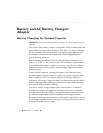
. . . . . . . . . . . . . . . . . . . . . . . . . . . . .
7-24 Reference — Camera
Battery and AC Battery Charger/
Adapter
Battery Charging for Optimal Capacity
IMPORTANT: Do not attempt to remove the battery; it is not a customer service-
able part.
The camera incorporates a single, rechargeable nickel hydride battery that
powers both the camera back and the Canon EOS-1 N camera; no batter-
ies are installed in the Canon camera. The Specifications appendix lists
the number of frames you can expect from a fully-charged battery in
typical shooting situations.
Battery charging is inhibited when the internal battery temperature is
above 113˚ F (45˚ C). The camera system will continue to operate for as
long as the battery charge is sufficient; however, you will not be able to
charge the camera system until the internal battery temperature drops
below this limit.
Under normal conditions, charging the battery for at least two hours
provides optimal capacity. However, under very cold or very hot condi-
tions, charge for at least 30 minutes after the LCD battery indicator
indicates a full charge. Charge the battery as close to the time the camera
will be used as possible. (Waiting in excess of two days before shooting
will result in reduced battery capacity.)
Use the AC battery charger/adapter when connected to a computer if
possible; use without the adapter in this configuration for an extended
time period will drain the battery. Leaving the camera connected to the
AC battery charger/adapter will not maintain a full charge; therefore
disconnect before use, then reconnect and charge for two hours to ensure
a full charge. Extended camera metering or focusing reduces the number
of images available from a charge.


















